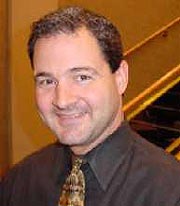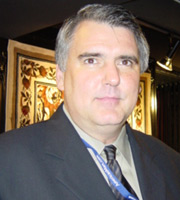February 12, 2004
'INVISIBLE LINE' ERASED AS
ORIENTAL WEAVERS' TWO DIVISIONS
MOVE TO BECOME A SINGLE ENTITY
|

Mike Riley
|

Steve Stultz
|
By Lissa Wyman
The invisible line that separated the products and personnel of Oriental Weavers USA and Sphinx by Oriental Weavers has been erased.
That is the first and most obvious change at Oriental Weavers showrooms since the company announced the merger of its two American divisions last fall.
Not so obvious are the ongoing behind-the-scenes adjustments that will make the once-separate companies a cohesive single entity.
Rugnews.com discussed the changes with OW's top executives at the recent Atlanta International Rug Market and the Surfaces Exposition in Las Vegas.
"There will still be two distinct brands -- Sphinx and OWA -- but both brands will now rely on the same manufacturing, distribution and back office resources," explained Mike Riley, executive vice president of Sphinx.
Riley will remain in charge of the Sphinx brand and Steve Stultz, senior vice president, will remain in charge of OWA. Field sales will be handled largely by account specialists for OWA and on a geographic basis for Sphinx. The sales force will sell both brands.
"There has been understandably a little confusion in the market, but overall the reaction to the consolidation has been favorable," said Stultz.
"The OWA brand will be geared 100% to big boxes and major chain stores, while the Sphinx brand is aimed at department stores and independent furniture, floor covering and rug stores," Riley said.
Both brands will share all the resources available from parent company Oriental Weavers Group, which has facilities world-wide.
OWA's products will continue to be manufactured domestically. Sphinx products will be made in Egypt, China, India and the U.S. Both brands will be distributed and serviced out of Oriental Weavers facilities in Dalton, GA.
"Off shore sourcing has cost advantages, but domestic manufacturing has service advantages," noted Riley.
"With four distribution centers, and a 96% fill rate, we can fulfill or commitments in terms of both stocking and delivery."
The game is service, but it's also marketing and merchandising, Riley noted. "The bottom line is, we've just got to be better than the competition."
"Between the two brands, we introduced 17 new collections with price points from $49 to $1,000. That's a lot of rugs to keep track of," said Stultz.
Product Development
In the future, much of the product development for the U.S. brands will be handled in the United States. The corporate team is led by Yasmine Khamis, who is research and development manager for the Oriental Weavers Group in Cairo. However, Riley and Stultz will play an active role in new product selection.
Last year Oriental Weavers opened one of the largest showrooms at 295 Fifth Ave. Does that mean the company will be developing home textiles products?
Company executives are mum on the subject. "It's a possible option down the road," said Riley. "We continue to look at new areas for development."
The overall goal of consolidation is to service the entire spectrum of retail channels with the efficiencies of one operational system.
"The mission is to offer the most products from one company and make those products viable for each market sector," said Stultz.
The consolidation of the two companies has not been completely painless, both Riley and Stultz admit. "In the long run, however, we feel that the changes will be worthwhile in terms of growth for both the company and the employees," said Stultz.